Sound Alliance. You mightn’t be familiar with the name, but most Australian web users will be aware of their music communities: inthemix, FasterLouder, and recently, Mess+Noise. The alliance was formed when Neil Ackland joined Libby Clark and Andre Lackmann, who launched dance music community inthemix out of a spare bedroom in 2000. They’ve since expanded to a team of 45. Their influence on the Australian web industry is huge, so when the opportunity to interview Neil arose, I jumped at it.
Andrew: Neil, you’ve obviously had a lot of experience with planning, goal setting, and so forth for the Sound Alliance. When planning a new venture, have you found it’s best to shoot for the top, as opposed to aiming for a less ambitious goal?
 Neil: I think it depends on how you value success, really, in terms of shooting for the top. I think we’ve taken a very long-term view to a lot of the ventures that we’ve launched. I think the game we’re in is not a make-a-quick-buck game, by any stretch of the imagination. I think our intent here is of running inthemix, for example, and sites like FasterLouder, and Mess+Noise, and [gay/lesbian community] SameSame require constant energy, nurture and investment – both in terms of time and money – to get them to continue to grow and to continue to flourish.
Neil: I think it depends on how you value success, really, in terms of shooting for the top. I think we’ve taken a very long-term view to a lot of the ventures that we’ve launched. I think the game we’re in is not a make-a-quick-buck game, by any stretch of the imagination. I think our intent here is of running inthemix, for example, and sites like FasterLouder, and Mess+Noise, and [gay/lesbian community] SameSame require constant energy, nurture and investment – both in terms of time and money – to get them to continue to grow and to continue to flourish.
I don’t think we ever went into this thinking that it was going to be a massive success [when inthemix first began in 2000]. We just saw an opportunity in the market to do something a little bit interesting. We saw some gaps there, and fundamentally just believed that online was the way of the future for the way people were going to consume content. Whether that happened in a year or ten years, we were confident that was eventually going to be the way it was going to go.
Over the last couple of years, it’s started to really bear fruit. I think we’re an ambitious bunch and we obviously want each of our media properties to be the leading destination within that category. We didn’t come into it saying, “Let’s go global, and take in the world and become the next MySpace,” or whatever. It was always much more about providing a good solid base for Australian music fans, I suppose.
What were your goals with Sound Alliance for those first couple of years?
I’ll put it in context for you. Before we had Sound Alliance, inthemix [ITM] was the first business that we launched. It was set up as a hobby. We came together, the three partners here, and we’re all really passionate about dance music and electronic music, and we set it up as something that we do in or spare time, outside of our day jobs, and very humble beginnings.
We never really had any great aspirations of it becoming Sound Alliance, at that time. It was more a case of wanting to do something we were really passionate about. All of us had day jobs that didn’t really fulfill our entrepreneurial flair, our passions, or our interests. They were just day jobs. We wanted to do something a bit different outside of that.
It just flourished from there. The first couple of years were about were trying to establish enough of a business model around inthemix so that one day we could stop doing our day jobs and do it full-time. That was the first goal and the first dream that we wanted to achieve.
It must have been an amazing time, at the point where you could quit your day jobs and focus on inthemix and Sound Alliance as a business.
Yeah, I actually got fired from my job, so…
That was convenient!
[Laughs] It was actually the best thing that ever happened, to be honest with you. It was a good time. It was really exciting. I think whenever you’re launching a new business, you’re young, enthusiastic, and you are confident in your ideas and you want to go out there and have a go, it’s a really exciting time. I think that is what I love about setting up new businesses, that feeling of something new. I think ultimately, the three of us are all entrepreneurs at heart. We get a real buzz from seeing things, coming up with ideas, or working with other peoples’ ideas and taking them through to fruition.
I look back on that stage of my career very fondly, because at that time, the game was much more about something that you’re really passionate about. I was just bouncing out of bed in the morning, really enthused and excited about the day. Working all the hours, going out on the weekend and getting amongst it and really immersing myself and seeing, and enjoying something that was very fresh and new at the time.
inthemix was one of the first online communities in Australia that really had some momentum behind it. It was really exciting to be a part of that. You really felt like you were part of something bigger than just a business. It was much more than a business. It was a bit more of a movement, I suppose, at the time.
So from starting as a part-time hobby, and not really measuring your goals in any specific way, how has that changed since Sound Alliance has become a profitable business, of late, with its numerous ventures?
It’s changed a lot in a sense, but now there is a lot more responsibility. It’s far more professional and the scale of it has changed dramatically over those ten years. The same fundamentals exist; we’re still passionate about our product and our sites, and we’re really passionate about the subject matter: the music industry in general, and being a part of that.
I think that running a team of 45 staff is a big responsibility. I think our business skills have probably expanded and evolved over time, quite a lot. I think we’ve really been able to refine our business model and our business skills, and learn about quite a diverse range of areas within the music industry. It’s become a real business now, rather than just a hobby.
That’s good, because if you do the same thing for a long period of time, it has to constantly evolve and change, otherwise, you can’t stay engaged at the same level. I think for the three partners in this business, it feels like every year we’re almost taking on a new role and a new challenge. We’re constantly engaged, so it doesn’t feel like we’ve been in the same job for ten years because we haven’t; we’re always doing something new and fresh and interesting. It keeps us focused and really engaged with the business.
You and your Sound Alliance co-founders were recognised as ‘Creative Catalysts’ earlier in the year. Are you often approached by young people who view you as a source of creative inspiration, or was that a new experience for you?
We were really surprised by that. We were quite honored to be included in that list. I wouldn’t say that type of thing happens very often. I think we probably try to provide as much inspiration as possible to the people within our team: our staff, our contributors, our state editors and that type of thing, whenever we get an opportunity to speak to them face-to-face, or get some time with them. I think inspiration is really important.
We put a lot of effort into trying to nurture talent within our business. We’ve had a lot of staff who joined us as contributors. Tim Hardaker joined inthemix as a part-time writer when he became a contributor while he was at uni. He’s been with us for six years and is now the General Manager of inthemix. Those are the types of things that we are quite proud of, in terms of not just giving people inspiration, but giving them opportunities to succeed, as well.
In the early days of Sound Alliance, who were your sources of inspiration?

I was inspired by quite a few people in a lot of different areas, just generally people around me. I was quite inspired by different promoters and DJs. When I first came to Australia in ’98, I met quite a few different people around the Sydney scene. I found it really vibrant and really open and welcoming, versus what I’d experienced in the U.K.
There were some interesting inspirations. Jon Peters, who was the brainchild of kGrind, back in the day. He was a really interesting guy who had some really stretched thinking and really out-there ideas. He managed to get people to buy into his ideas and I found that really inspiring at the time; that the power of an idea could be enough to bring a whole group of people together behind something. That was quite inspiring. I was always inspired by people who had come from not much, but who had still been able to achieve a lot with a bit of street smarts and because they were passionate about what they did.
Did you have a mentor during that time?
I didn’t, actually. I’ve always relied heavily on my business partners, and them on me in return. I don’t think it would have been possible to do what we’ve done with just me running the business, or just the two of us. I think the “alliance” part of Sound Alliance is one of our key strengths.
There are so many facets of running a business and getting a business from where we were to where we are now. It’s not just beyond my own skill set, but just things I’m not passionate about that my other partners are, the technical or legal aspects or financial or accounting aspects of the business. All these different areas, I would look at any one entrepreneur who was able to launch a business on their own and try to do all those things and think that was pretty amazing, because the skill set required is really quite broad and quite vast. That’s why I always felt that I had support and a different skill set requirement amongst the three partners in the business.
We help each other through the tough times, and we share in each others’ successes.
Despite being the head of Australia’s largest independent online publisher, your personal online presence is reasonably subdued, in that you don’t tend to blow your own horn too often. Was this a conscious strategy from day one, or are you naturally modest?
I’m not crazy about being thrust into the limelight, it has to be said. I prefer to let the results and our products do the talking rather than me, always. In the last year or so, I’ve probably taken a bit more outward approach to getting our name out there. I’ve had some success around that, but I don’t know. There is so much to our business that is just about the team effort. I’m happy to fly the flag for the team, but I don’t really see it being something that’s about any one particular person.
You can see where I’m coming from though. Guys in their sales and advertising fields don’t tend to let their achievements speak for themselves too often. I respect that you’re pretty low key about your achievements. That’s really awesome.
I suppose I’m very aware of the tall poppy syndrome in Australia. I’ve seen a lot of people come and go, over the years, who have come out telling a big story and shouting from the rooftops about not a lot, in terms of actual delivery, or the reality of what they’ve got. I’ve always looked upon that type of thing with a bit of cynicism, and I just think it’s never really been our style. We’ve got a slightly different approach to the way we do things and that’s worked for us so far. We haven’t really felt the need to go shouting too much.
Is there a particular reason why you don’t share your business and motivational thoughts with the world, in the form of a blog, or is it just a matter of being time-poor?
It’s funny you say that. I am actually setting up a blog at the moment, which will be probably going live in the next few weeks. We’re going to combine blogs, so there will be a developers’ blog, which will be Andre [Lackmann] who is the CTO here. He and his development team want to share some of the work that they’ve been doing and invite input from other developers, around some of the social media tools. Myself, and Stig [Richards], who runs the agency [Thought By Them] here, will be updating our side of the blog, which will be coming at the music industry from amarketing/brands/advertising/digital kind of perspective.
A lot of it does come down to just being dedicated to something and being very time-poor. I’m interested in changing. I do read a lot of blogs and I follow some people whose opinion I really value. I think we’ve got some interesting stuff to share. I don’t think we’ll be updating it every day or anything, but I’m sure there will be some interesting tidbits coming through.
Definitely. I think you’d attract a significant audience if you guys told the story behind what’s going on with Sound Alliance and how you got there. That’d be a great story.
Cool, thanks for the feedback. Let me know what you think of the blog when it goes live.
I will do. Personally, my connection to Sound Alliance began when I started writing for FasterLouder in June 2007. I now write for Mess+Noise [pictured below right, in magazine form], and I’ve always thought it was interesting that one of these sites pay its contributors, while the other doesn’t. What’s the difference between the two?
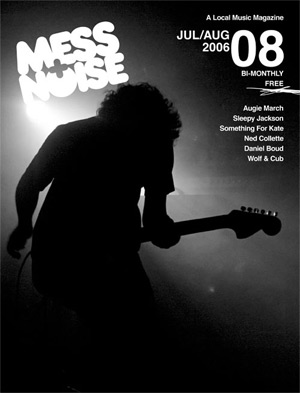 When we were initially presented with the opportunity to acquire Mess+Noise, we were really interested in the community. We really loved what they’ve been able to create and recognized how unique it was, in the sense that it really didn’t take a lot of time and a lot of different factors to create success in terms of doing a community online. Those guys have achieved that really well.
When we were initially presented with the opportunity to acquire Mess+Noise, we were really interested in the community. We really loved what they’ve been able to create and recognized how unique it was, in the sense that it really didn’t take a lot of time and a lot of different factors to create success in terms of doing a community online. Those guys have achieved that really well.
One of the things we were really attracted to about Mess+Noise is that it had a real focus on allowing its writers to focus on quality, and not be constrained by either an advertorial approach to content or word limits, or the speed at which they had to respond. They very much did things their own way, at their own pace, and they said exactly what they wanted to say. We really respected that. I liked that about what they were doing.
I think FasterLouder, for us, is a great platform for writers, photographers, and creative people to start engaging with the live music scene. I think the way we would view Mess+Noise is that it was less about the immediacy of having the gig review and photos up a couple of days after the gig; it was much more timeless, and focused on quality over quantity.
We wanted to take a different approach with Mess+Noise and try to focus on that; really try to nurture some of the great professional writers and professional photographers who are out there, and bring them across to Mess+Noise to engage with the site.
Our reason, I suppose, is that a young writer could hone their skills, cut their teeth if you like, by contributing to FasterLouder, and eventually when they’re ready, they’ll be able to move up to start writing for Mess+Noise, and start to be paid for what they do. That’s the path we’re hoping we’re able to take young writers and young photographers on, and that they can see that we can nurture those skills, give them feedback, and pass them through that process to a point where they can hopefully become professional writers or professional photographers.
That’s really cool that you talk about it like that because I’d like to continue the discussion along those lines. I found my experience to be exactly what you said. Taking the time to contribute for free is wonderful and a great opportunity for people who are just starting out in web publishing; often the experience, the community feedback and the industry freebies are seen as a reward in themselves. But as you know, there comes a time when these free contributors decide to move onto paid work. I think the Australian street press has a similar staff turnover: writers learn the ropes and then tend to leave within a few years.
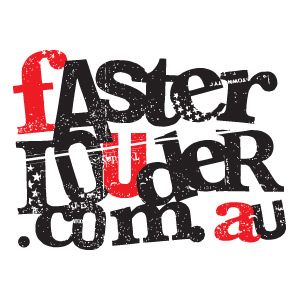
I think it’s really tough. It’s changed the dynamics and the economic structures of a whole range of things. The one thing I do think something like FasterLouder helps provide is an opportunity for feedback. It gives a great feedback loop and an opportunity for writers to see how many people have viewed their articles, and to get people to ‘heart’ and comment on it, discuss it. I think that is one of the great things that FasterLouder offers, in terms of being able to get some feedback on your writing.
You could put something out on a blog about a gig that you went to on the weekend, but the number of people who are likely to see it is quite limited. I think you get to expose your work to a broader range of people and the pressure is not as intense, and as high as it would be as if you were writing for a very critical, discerning audience on a site like Mess+Noise. The parameters are not quite as restrictive.
I think that’s really cool that you guys have kind of had that strategy from the start at FasterLouder, and then progressed on to Mess+Noise when the time was right.
I think we tried to adopt that approach even before we had Mess+Noise, in the sense that the heads of the talented and the really passionate always pop up above the crowd, and we try to bring them in. As I said before, we’ve got staff here who came through that contributor process, and have now come through to be full-time employees down the line, or just contributors being paid by Mess+Noise.
There are not millions of opportunities, but they do come up occasionally. Where possible, we always try to include the people who’ve worked with us over that time.
The people who are really outstanding do tend to rise above the crowd and receive more opportunities, so it’s kind of a natural selection process. That’s cool. Moving on; your LinkedIn profile states that you’re adept at establishing profitable business models from niche social media.
You’ve done your research!
How long did it take for inthemix to become profitable, broadly speaking?
Off the top of my head, I’m not entirely sure about inthemix. I think inthemix was probably more of a phenomenon than even we thought it was going to be. Our approach with what we did with our business was always to reinvest. inthemix, in isolation, had we just kept that company running as five or six people working on the business, it would be an extremely successful business, but what we’ve chosen to do is to build our company out, create Sound Alliance, and reinvest all that money back into building the business we have today.
I think in isolation, inthemix is still a fantastic company, business, and community; all of those things, and it continues to grow. Every time we think we’ve definitely reached our maximum audience at the site, it defies belief and keeps on going. That’s a really solid business model right there. I didn’t really answer your question, did I?
No, not specifically, but that’s okay. [Laughs] Has Sound Alliance ever sought venture capital funding?
Yes, we have. We’re one of the few Australian companies in our industry who have succeeded in getting venture capital funding. I know a lot of people who have tried and failed. The process is exhausting, and it’s a whole new world out there, I can tell you.
We managed to get a round of funding last year, and the partner is Albert Investments Group, which is a parent company of Albert Music, the publishing and recording business. They have music studios over in Neutral Bay; they’ve got AC/DC and Dallas Crane, and a few other acts. They’re a really great fit for us.
We’ve really seen eye-to-eye with them in terms of the cultural sphere of our business and the fact that they’re family-run. They’re one of the oldest music businesses in Australia, and they ended up being a really great partner. There were a lot of companies fishing around out there when we were entering that ‘boom’ period just before the financial crisis There were a lot of conversations going on. I don’t think there was a single online company worth its salt that hadn’t been approached by numerous people, at that time. It was just the way it was back then.
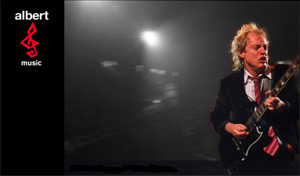
We’re very fortunate. We managed to take on a partner as a minority shareholder in the business, who shares our goals and our vision for what we’re trying to achieve. They are hugely supportive in getting us there, and have been able to provide a lot of value and not just in terms of capital investment, but in terms of the network they’ve been able to open us up to, their skills, and knowledge of the music industry have all been invaluable.
So you guys had pursued that for most of your time as Sound Alliance, but you only found a partner, just last year?
No, we’d only been out there looking for about nine months, or something like that. It wasn’t something that had been a priority prior to that.
Returning to yourself; do you have a daily routine?
Not really. If I had the choice, I would probably a lot more routine focused. My day is pretty irregular, in terms of what happens. I have a lot of regularly scheduled meetings that happen week in, week out but outside of that, I could be pulled in any number of directions, depending on what’s going on at any one time.
In a way, I kind of like that aspect of my role, in that it’s very dynamic and it requires me to use left brain/right brain, and switch on and off in different occasions and at different times. It’s what keeps it really challenging. No, I don’t have a massive routine in terms of the way I structure my day.
Has this changed since you started ten years ago?
I wouldn’t say I’ve always been a massive routine person, in terms of what I do. I will always try and dedicate some of my day to researching into keeping up with what’s going on out there. I don’t always do it at the same time every day, but I’ll always spend some of my day doing that whenever I can sneak it in; when I’m on a cab checking my phone, checking out news stories and blogs, or when I get home before I go to bed at night, or however I can squeeze those types of things in. I don’t say “At 9:00 in the morning, I’m going to do this for twenty minutes.” I’m a bit more sporadic than that.
Do you ever struggle with procrastination?
When I’m tired, yeah, but I tend to make quite quick decisions. I’ve learned over the years that you can’t dwell on things too long. You have to use your instinct and your gut to make a lot of your decisions, where when you’ve got time to procrastinate and pore over the details, that’s great, and sometimes I’ll do that. But generally, my instincts will tell me which way to go and I just don’t have the time to procrastinate.
So you don’t have any trouble remaining focused on the task at hand? You just devote the time necessary and then move on?
Yeah, I think I can get through quite a bit of stuff quite quickly. I can process a lot of things during the day and move through quite a few things in a short space of time. If I have to focus on something, I’ll go home and work from home. If I’m writing something really important or working on numbers or spreadsheets, I’ll put my headphones on or get out of the office and try to focus on it there.
Let’s talk about [Sound Alliance marketing consultancy arm] Thought By Them for a moment. Is it at the stage where companies and events come to you for consultancy or do you guys still submit proposals for these projects, like regular businesses?
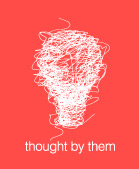 It’s a lot more people coming to us now. It used to be, in the early stages, us going out there and trying to tell people about what we’re doing. We’ve never really been out there in terms of pitching all the time, and trying to win big pitches. We have taken the approach that what we’re offering is quite a specialist thing and it doesn’t suit all brands; it only suits certain types of brands at some stage in their lifecycle. More often, they’ve kind of found us rather than us finding them.
It’s a lot more people coming to us now. It used to be, in the early stages, us going out there and trying to tell people about what we’re doing. We’ve never really been out there in terms of pitching all the time, and trying to win big pitches. We have taken the approach that what we’re offering is quite a specialist thing and it doesn’t suit all brands; it only suits certain types of brands at some stage in their lifecycle. More often, they’ve kind of found us rather than us finding them.
With Thought By Them, we didn’t want to get too big, too fast. We try to focus on delivering really good value and really good ideas, and constantly innovating, rather than exploding and taking on too many clients. We’ve really focused on having one client in one brand category, rather than having a lot of different clients in the same category.
It’s been a really organic approach. I think that’s really suited us because we’ve been able to learn a lot during that time, and really hone our skills, like how unique our position is in the market.
How did the music licensing and CD production arm of Thought By Them come about?
We don’t do too much of that at the moment, to be honest. It was really more a case of just seeing opportunities for brands. We don’t tend to work within strict disciplines, in terms of our work arrangements and that type of thing. We tend to be quite fluid, and try and react as things are going on amongst consumers and provide our solutions right to that, rather than sticking within a mandate of just being a digital agency, or an events agency, or a music agency.
With music licensing, and that type of thing, if it’s the right solution for what one of our clients is looking to achieve, then we would recommend it. It’s not something that we roll out as part of any standard product offering.
I’m assuming that digital music distribution has affected the CD production aspect that you guys offer.
Yeah, but the CD production stuff is such a small part of what we do. We’ve only really done it a few times for specific clients when it’s been a requirement, but it’s not really a core part of what Thought By Them is doing.
You’re a few years older than me, so you knew a time before the web dominated our means of mass communication. Something that I’ve been doing more and more in the last year is reaching out to individuals who inspire or fascinate me, such as yourself. Do you have any tips for approaching these seemingly ultra-busy, really important figures?
[Laughs] I can only look back on the people who have approached me, and the ones that have had success in doing so. I’ve never shut the door on anybody or denied anybody my time, if they’ve been polite in the way they’ve approached me and I think I can assist them. If they’ve taken an interesting approach, then I’ll always give my time.
I’d be surprised if many other people who are in the industry would take a much different approach to that, but I’m sure some people do. Generally speaking, I think if people were reaching out, asking for information and advice, I’m more than happy to try and provide it, if I can squeeze in the time.
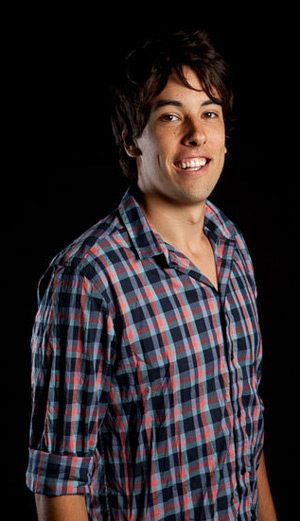 With Nick Crocker [pictured right; Native Digital owner, and my mentor], for example, when he first got in touch with me, it was a matter of a mutual friend saying, “Hey, you should catch up with this person. It’s worthwhile meeting up with him,” as he came to me through Luke at Universal. There was never really an agenda. It was just an interesting guy worth catching up with, much the same way as he now passed your details along to me, and we’re talking today.
With Nick Crocker [pictured right; Native Digital owner, and my mentor], for example, when he first got in touch with me, it was a matter of a mutual friend saying, “Hey, you should catch up with this person. It’s worthwhile meeting up with him,” as he came to me through Luke at Universal. There was never really an agenda. It was just an interesting guy worth catching up with, much the same way as he now passed your details along to me, and we’re talking today.
I think it’s good to really try to work on your network. You don’t always have to start by targeting somebody who is right at the top of your inspiration tree. You can find your way there by other means.
It’s best to just have a go. I think you’d be surprised; a lot of people have this misconception of “Oh my God, I could never just find that person’s email address, or contact them through LinkedIn or Twitter, and ask them if they fancy coffee.” There is no harm in trying. I think you might be surprised. I’ve probably had a couple of people approach me with an ulterior motive; maybe they were a recruiter or something like that and I might not have got back to them, but generally speaking, if I think it’s somebody who is doing it for the right reasons, I’ll always respond.
I’ve definitely found what you mentioned about being surprised about who will meet up with me. It’s an approach that Nick introduced to me this year, and I’ve definitely been blown away by the response, the respect and attention that I’ve received from some people I would have never thought would have given me the time of day. It’s pretty amazing.
There is this outward perception that the music industry is so unapproachable, and that all these people are up on a pedestal, but it’s not like that at all. I think they’re all just real people doing their thing, and one of the things that always attracted me to work in the music business is that I saw this bunch of people that had all come together of their own steam. Their own entrepreneurial tendencies and flare are at the core of what the music industry is all about. It’s a whole bunch of people who are really passionate and determined, and they really love what they do and really love the industry itself.
I’ve found it’s quite consuming and quite seductive to be so drawn into a space by that. That’s why if you’re talking about getting someone’s time, they’ve all been in that position before, so I think most of them recognize that and they’re happy to pass on any pearls of wisdom they might have, to do their bit.
Much as you have, today. Did you have any specific tactics that you used to connect with inspirational or motivational figures when Sound Alliance was starting up?
Not really. I would just try and make sure that I was very present. I think if you’re really passionate about working in the music industry, you have to walk the walk and talk the talk. You got to do your research, get out there, go to the gigs, go to the clubs, or whatever your particular genre interest is. Meet the people, network, and get amongst it. That’s how opportunities and many things arise. I think you’ve got to live the life and get amongst it if you really want to be taken seriously in getting into this space.
We’ve just been interviewing some staff this week. We invited some junior staff members to come back in and do a presentation to us on some ideas of how they would help promote some releases. The presentations yesterday were from this young guy and girl, and I was blown away by the amount of research they’d done, and how they seem to know our product. They’d gone into this great level of detail to understand what it was they were coming back with, even though they hadn’t really been given direction. Even though their ideas were slightly off in some areas, it was so impressive just to see people going to that level. I think that’s what it takes to get your foot in the door in this industry: you have to really stand out, and be really prepared to go the extra mile.
There are a lot of people who just think “Oh yeah, it’d be cool to work in music,” or cool to work in fashion, or whatever, but it’s not really the right reason to be involved in something.
My final question, Neil, I understand that Sound Alliance has a new web project on the horizon. Can you give me any hints on its focus?
We’ve got quite a few actually. I don’t know which one you’re talking about. [Laughs]
I can talk about a couple of things we’re doing. We’re re-launching inthemix towards the end of this year, though there’s no specific date set yet. It’s a fairly major sort of overhaul for inthemix, in terms of functionality, tools, the design, and what it offers.
I think it will send that whole community off onto the next level, in terms of their engagement with the site, what they can do with it, and what it can give them. That’s something really exciting, whether you’re a DJ, producer, or just a punter, we’re going to offer a lot of things on those levels that are going to enable them to connect to other people in the same space and really take the essence of what ITM’s strengths are and style them up a little bit more.
inthemix has been running on the same platform for about four years and we know it’s a little bit tired and dated; it’s not exactly Web 2.0. We’ve been honing a lot of those tools on our other sites and seeing how people use them and interact, and getting them ready to roll them out on the big beast [ITM]. That’s a pretty exciting project for us, pretty massive, and it brings to an end about a four-year development schedule.

We’ve basically been putting all of our sites onto one codebase, one unified codebase. It basically means you’ll be able to make a change or add a new piece of functionality and they’ll all simultaneously go across all the sites. It will just have a slightly different front-end design look and feel. It will mean we will be able to get new developments to the market quicker, cheaper, and much more effectively without reinventing the wheel every time. This is quite a big launch for us.
We’re also working on a whole heap of mobile stuff at the moment; we’re just about to launch a mobile site for Mess+Noise, to give that a try. We’ve launched mobile sites for inthemix forums, and we’re going to be rolling out a whole range of mobile stuff, possibly some apps, and a few things down the track, as well.
We have this other thing called Sound Alliance Labs which we just launched recently, where we’ve allocated a budget every year, and our staff can pitch their own ideas for development. We have a monthly meeting where they have to come in and pitch ideas, not necessarily revenue-generating, not necessarily great business ideas, but just things they’ve seen or things they think would complement what we’re doing. They can either pitch them to the management team either individually or as groups.
If we like their idea, we give them a budget and they can work on it outside of their hours. So if the developers come up with a great idea for an iPhone app or something like that, we give them a budget and pay them outside of their standard work hours to go away and develop it. We’re going to give an award for the best lab project every year, based on all the submissions that come through. We’re trying to maintain a focus on innovation and make sure that our staff have an opportunity to do all the things they’re really interested in outside of work, while bringing the benefit back to Sound Alliance, for the greater good of the overall company rather than going off and doing them on their own. We can just see a lot of our team working on some really exciting things, and we wanted to bring that within these walls, rather than see that innovation go off elsewhere. It’s things like that which are exciting and fun and challenging.
And it’s fascinating for an outsider. It’s been really interesting to hear you speak about your past, the present, and the future. It’s been great to speak with you, Neil, and I thank you for your time.
Cool, happy to share with you. I hope it’s been useful, and I look forward to seeing what’s ahead for you.
If you’d like to get in touch, Neil Ackland is on the emails and the Twitters. Coincidentally, Denise Shrivell of Digital Ministry published an excellent interview with Neil earlier this week that focuses on the business side of Sound Alliance. Take a look.
The Gin Club – Deathwish

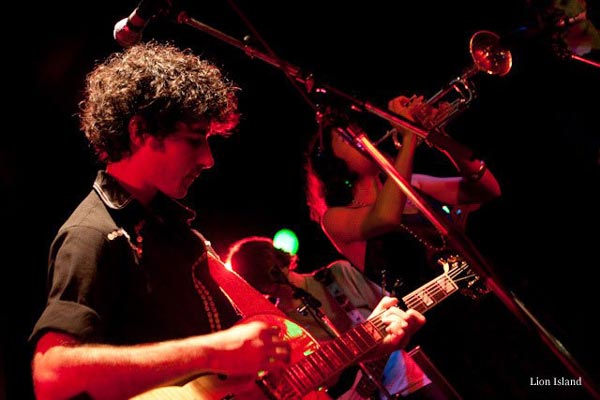
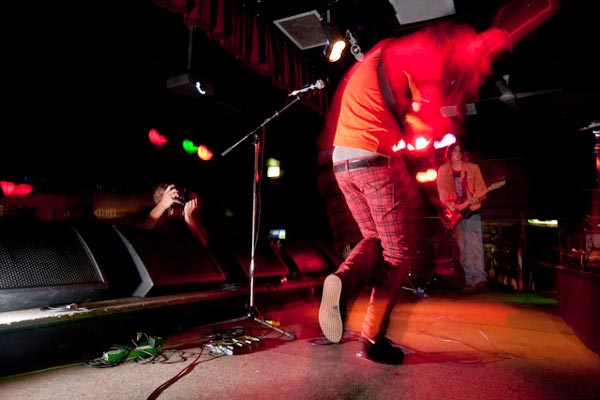
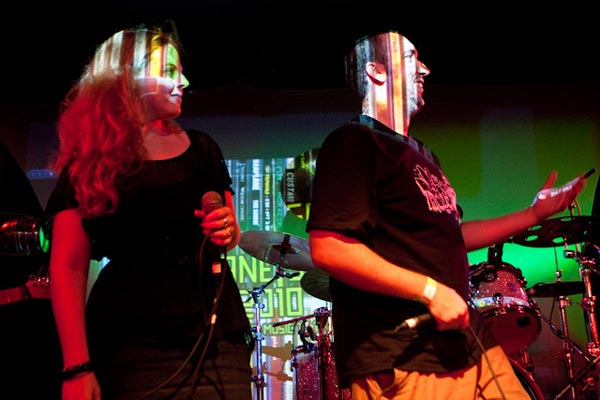
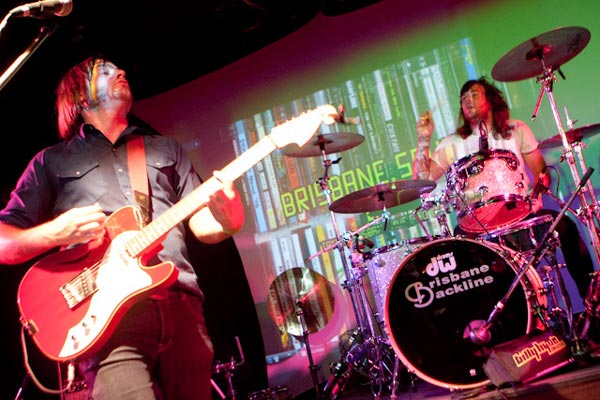


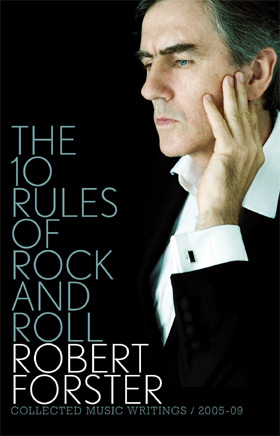 You can take umbrage with any you wish to do. Rock and roll needs rules, and I’m glad that you’ve finally laid them down. I like the idea of the two things coming together because rock and roll, theoretically, it’s supposed to have no rules. That’s what it is founded on, to an extent, or the myth is that it has no rules. Obviously, the point of the rules and the point of the book being named that is to bring these two things that normally don’t go together, rules and rock and roll, together. Is it true that in writing about music, which is what you now do, that’s not saying you don’t continue to make music; you obviously do, but in writing about music, do you apply rules? Are they similar? Yeah, one of them is I try not to put myself too much in each piece, or go to ‘I’, which is a great, great temptation. I pull myself out, because sometimes I have connections. In one of the pieces in the book, which is on Delta Goodrem, I review her last album Delta, and it’s her third album. I reviewed the album. I did that about two years. What I don’t put in the article is that when The Go-Betweens were doing their second to last album, Bright Yellow, Bright Orange in 2004 in Melbourne in studio, she was in the studio. I didn’t know who she was because I’d lived over in Germany for a number of years. You didn’t know who she was? No. I’d lived over in Germany for a number of years, and she’d sort of come through Neighbours and things like that. I think she’d had one or two hits at this stage. It was a studio complex and we were in the main studio and she was in a room mixing a single with an engineer. When we were taking breaks from recording, we’d been out playing ping pong and she was sitting over on the piano. There was an old upright, a bit out of tune, and she’d sit and sing; not in any sort of flashy way, but a really nice way. She could play piano. She had a really good voice. It sounded really good. I only found out who she was later, but she would sit there and play, not try and impress, just because she felt like she could do it for hours. I only discovered who she was at that moment and I only heard her records later, but a couple of years later when I came to hear her record and it seemed like an odd choice to review a Delta Goodrem album, I remembered that I’d had that experience. I didn’t put it into the review because I didn’t think it was needed. One rule is when to put myself in and out of the reviews. I suppose an earlier rule, in a sense, then, is what to choose to review. How do you get to a point of choosing what you want to write about? Perversely enough, it seems to be the ones that I think I know something about, or that I have personal experience with. A band like Franz Ferdinand, who I really liked, like right from the first album. They’re a Glasgow band. The Go-Betweens, in the very early ‘80s, were on a label called Postcard in Glasgow. We were around Glaswegian musicians like Orange Juice, Josef K, Aztec Camera; we knew these people. And so when Franz Ferdinand, these sort of four Glaswegian arty, hipsters came along in 2005 with the great first album, I loved the album and I would have loved it if I hadn’t have known that they were from Glasgow, but the fact that they were just brought it a little bit closer. When I was thinking of an album to review, I reviewed their second one. I put that in a review and there is a paragraph about Glasgow. It’s just from personal experience. That is part of the thing; that I have a connection, that I think I know something about the record, or the concert, helps.
You can take umbrage with any you wish to do. Rock and roll needs rules, and I’m glad that you’ve finally laid them down. I like the idea of the two things coming together because rock and roll, theoretically, it’s supposed to have no rules. That’s what it is founded on, to an extent, or the myth is that it has no rules. Obviously, the point of the rules and the point of the book being named that is to bring these two things that normally don’t go together, rules and rock and roll, together. Is it true that in writing about music, which is what you now do, that’s not saying you don’t continue to make music; you obviously do, but in writing about music, do you apply rules? Are they similar? Yeah, one of them is I try not to put myself too much in each piece, or go to ‘I’, which is a great, great temptation. I pull myself out, because sometimes I have connections. In one of the pieces in the book, which is on Delta Goodrem, I review her last album Delta, and it’s her third album. I reviewed the album. I did that about two years. What I don’t put in the article is that when The Go-Betweens were doing their second to last album, Bright Yellow, Bright Orange in 2004 in Melbourne in studio, she was in the studio. I didn’t know who she was because I’d lived over in Germany for a number of years. You didn’t know who she was? No. I’d lived over in Germany for a number of years, and she’d sort of come through Neighbours and things like that. I think she’d had one or two hits at this stage. It was a studio complex and we were in the main studio and she was in a room mixing a single with an engineer. When we were taking breaks from recording, we’d been out playing ping pong and she was sitting over on the piano. There was an old upright, a bit out of tune, and she’d sit and sing; not in any sort of flashy way, but a really nice way. She could play piano. She had a really good voice. It sounded really good. I only found out who she was later, but she would sit there and play, not try and impress, just because she felt like she could do it for hours. I only discovered who she was at that moment and I only heard her records later, but a couple of years later when I came to hear her record and it seemed like an odd choice to review a Delta Goodrem album, I remembered that I’d had that experience. I didn’t put it into the review because I didn’t think it was needed. One rule is when to put myself in and out of the reviews. I suppose an earlier rule, in a sense, then, is what to choose to review. How do you get to a point of choosing what you want to write about? Perversely enough, it seems to be the ones that I think I know something about, or that I have personal experience with. A band like Franz Ferdinand, who I really liked, like right from the first album. They’re a Glasgow band. The Go-Betweens, in the very early ‘80s, were on a label called Postcard in Glasgow. We were around Glaswegian musicians like Orange Juice, Josef K, Aztec Camera; we knew these people. And so when Franz Ferdinand, these sort of four Glaswegian arty, hipsters came along in 2005 with the great first album, I loved the album and I would have loved it if I hadn’t have known that they were from Glasgow, but the fact that they were just brought it a little bit closer. When I was thinking of an album to review, I reviewed their second one. I put that in a review and there is a paragraph about Glasgow. It’s just from personal experience. That is part of the thing; that I have a connection, that I think I know something about the record, or the concert, helps.  It doesn’t explain Delta Goodrem [pictured left] yet, though. I always end up talking a lot about Delta. We can let it go. No, I’ll add to what I was saying. My niece had some of her records in the time between I’d seen her in the studio. She’d become a big star so I was aware of her and I actually quite liked a single of hers called “Born to Fly”, which I think is on her first or second album. If I had to choose ten great Australian songs over the last decade, I’d put Delta Goodrem’s “Born To Fly” in there. It’s a great MOR, big ballad. It’s a fantastic song, which she co-wrote, to her credit. It seems like there would be a danger in reviewing when there was no connection, and that would be the point where there would be a danger of bringing yourself into what you’re writing, or purely being about the technicalities of what you’re listening to if there is no connection. I would imagine the connections go way back with you into your past. That’s the reason why you choose
It doesn’t explain Delta Goodrem [pictured left] yet, though. I always end up talking a lot about Delta. We can let it go. No, I’ll add to what I was saying. My niece had some of her records in the time between I’d seen her in the studio. She’d become a big star so I was aware of her and I actually quite liked a single of hers called “Born to Fly”, which I think is on her first or second album. If I had to choose ten great Australian songs over the last decade, I’d put Delta Goodrem’s “Born To Fly” in there. It’s a great MOR, big ballad. It’s a fantastic song, which she co-wrote, to her credit. It seems like there would be a danger in reviewing when there was no connection, and that would be the point where there would be a danger of bringing yourself into what you’re writing, or purely being about the technicalities of what you’re listening to if there is no connection. I would imagine the connections go way back with you into your past. That’s the reason why you choose 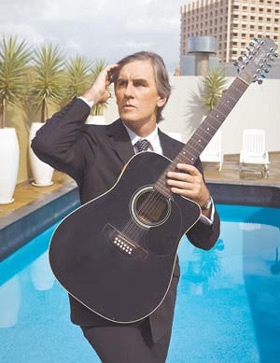 Exactly. I am fantastic. That was brilliant, John. I’ve been bullshitting at the university now for a number of years. It’s being taped by the way. You can try it in your lectures. I found a typo on page 249, would you like me to – Tell me later. I wrote here, “There are things with which I concur.” Nash Chambers did a great job on that album [
Exactly. I am fantastic. That was brilliant, John. I’ve been bullshitting at the university now for a number of years. It’s being taped by the way. You can try it in your lectures. I found a typo on page 249, would you like me to – Tell me later. I wrote here, “There are things with which I concur.” Nash Chambers did a great job on that album [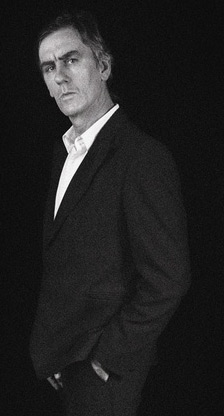 I didn’t read it. You looked at the pictures. I didn’t even look at the pictures. It was a door stop. You sat on it maybe as a cushion? [laughs] I’ll read a really thick book on Willem de Kooning, that’s got really good reviews. I’ll read that, and I have a passing interest in his art, but I love the story and things will come out to me that will be a lot like de Kooning, one of the great 20th Century artists; he didn’t have his first solo show until he was 45. I found that amazing. I found that enriching, and a great fact to know. I’ve always been a biography reader so it’s really no surprise that I enjoy dealing in facts with a little bit of imagination as opposed to, you know, “Cecilia Page lived down at Redcliffe Pier and had 15 children…”. I don’t just leap off into a story. It seems beyond me. The biography thing, one thing I particularly like in the book is the
I didn’t read it. You looked at the pictures. I didn’t even look at the pictures. It was a door stop. You sat on it maybe as a cushion? [laughs] I’ll read a really thick book on Willem de Kooning, that’s got really good reviews. I’ll read that, and I have a passing interest in his art, but I love the story and things will come out to me that will be a lot like de Kooning, one of the great 20th Century artists; he didn’t have his first solo show until he was 45. I found that amazing. I found that enriching, and a great fact to know. I’ve always been a biography reader so it’s really no surprise that I enjoy dealing in facts with a little bit of imagination as opposed to, you know, “Cecilia Page lived down at Redcliffe Pier and had 15 children…”. I don’t just leap off into a story. It seems beyond me. The biography thing, one thing I particularly like in the book is the 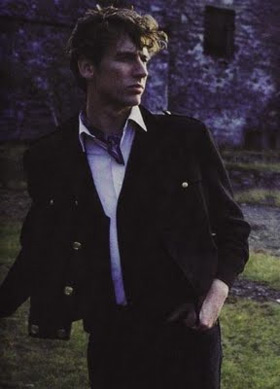 David McComb from
David McComb from 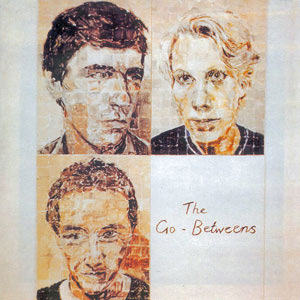 Audience: My name is Jenny Watson, and I did the album art for [The Go-Betweens album] ‘Send Me A Lullaby’ [pictured left]. Robert, I want to ask a question about when you walked into my flat and saw those small canvas paintings, and I’d only had five exhibitions and you said, “You’re doing our next album cover”. Are you usually that decisive in your business dealings? Because you were more decisive than any top-notch art dealer, I can tell you! Thank you, Jenny. I try and follow my instincts. That has got me into trouble at times. John: Are you impetuous? Not impetuous, but it’s like the idea of Brisbane is LA 1965, 1966; how far do you take that? John: All the way, baby! Oh well, it can get you into trouble and you can find that you’re trying to do something that the rest of the world doesn’t understand, which could be difficult. No, I try and – also the other thing is when I see great work before me, I always hope that I recognise it. I did on that circumstance, and I try and do that whenever I can. John: It’s a big thing, isn’t it, Jenny, having some of your work put on somebody’s album cover and spread around the world. Jenny: It was fantastic. It was in a book called ‘The Best 500 Record Covers in Rock and Roll’. Thanks for the publicity! John: Anybody else have a comment, statement, or a question? Audience: I’m really interested in the fact that the writing in this book is so beautiful. Just if you pick it up and read the first essay, you’ll realise that you’re in the hands of a master writer here. Stuart Glover, who is head of creating writing at the University of Queensland, said exactly the same thing. I wonder when you said that you will read any non-fiction; do you have non-fiction work that you won’t read? Do you have a filter where you say the writing has to be of great quality, or is it just the subject for you? No, there has to be quality with it. A great biography writer is someone like Richard Elman, who wrote a very good book on Oscar Wilde, and James Joyce. He’s one of the masters. John Richardson, at the moment, is writing a great biography. It’s his third volume on the life of Picasso. They’re fantastic books. There has to be a certain standard to keep me there, but I think it can also go – and something that I’ve always been interested in, is going-high brow and low-brow. It’s not indiscriminate taste, but I see value broadly, but there is a limit. I do have an autobiography of Shaun Cassidy, which I bought at an art shop, which I refuse to read. This was published in the mid ‘70s. I don’t touch it. Knowing you have it is enough. It is. No
Audience: My name is Jenny Watson, and I did the album art for [The Go-Betweens album] ‘Send Me A Lullaby’ [pictured left]. Robert, I want to ask a question about when you walked into my flat and saw those small canvas paintings, and I’d only had five exhibitions and you said, “You’re doing our next album cover”. Are you usually that decisive in your business dealings? Because you were more decisive than any top-notch art dealer, I can tell you! Thank you, Jenny. I try and follow my instincts. That has got me into trouble at times. John: Are you impetuous? Not impetuous, but it’s like the idea of Brisbane is LA 1965, 1966; how far do you take that? John: All the way, baby! Oh well, it can get you into trouble and you can find that you’re trying to do something that the rest of the world doesn’t understand, which could be difficult. No, I try and – also the other thing is when I see great work before me, I always hope that I recognise it. I did on that circumstance, and I try and do that whenever I can. John: It’s a big thing, isn’t it, Jenny, having some of your work put on somebody’s album cover and spread around the world. Jenny: It was fantastic. It was in a book called ‘The Best 500 Record Covers in Rock and Roll’. Thanks for the publicity! John: Anybody else have a comment, statement, or a question? Audience: I’m really interested in the fact that the writing in this book is so beautiful. Just if you pick it up and read the first essay, you’ll realise that you’re in the hands of a master writer here. Stuart Glover, who is head of creating writing at the University of Queensland, said exactly the same thing. I wonder when you said that you will read any non-fiction; do you have non-fiction work that you won’t read? Do you have a filter where you say the writing has to be of great quality, or is it just the subject for you? No, there has to be quality with it. A great biography writer is someone like Richard Elman, who wrote a very good book on Oscar Wilde, and James Joyce. He’s one of the masters. John Richardson, at the moment, is writing a great biography. It’s his third volume on the life of Picasso. They’re fantastic books. There has to be a certain standard to keep me there, but I think it can also go – and something that I’ve always been interested in, is going-high brow and low-brow. It’s not indiscriminate taste, but I see value broadly, but there is a limit. I do have an autobiography of Shaun Cassidy, which I bought at an art shop, which I refuse to read. This was published in the mid ‘70s. I don’t touch it. Knowing you have it is enough. It is. No 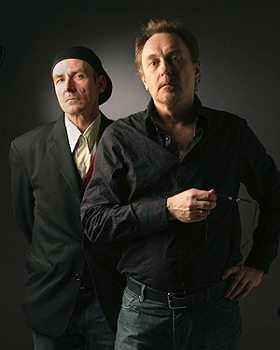 Really? See, this was the first show that the Go-Betweens ever played in Sydney at the Paris Theatre in 1980. The Paris Theatre has now been demolished. The bill for this night was The Go-Betweens on first, the
Really? See, this was the first show that the Go-Betweens ever played in Sydney at the Paris Theatre in 1980. The Paris Theatre has now been demolished. The bill for this night was The Go-Betweens on first, the  There’d have to be a couple of whiskey bottles then, I think. But no, I left that out [of the book]. To me, when I read it again, it read like it was written in pajamas on a lot of coffee, in a Canberra motor inn, in one day. I just thought “no, that can’t go in”. I think after the first 8 months, I think I’m a lot more consistent. There are a couple of pieces that I left out after, where I just failed. The other thing that I have to admit is I started this at 48. I wrote a piece on Lucinda Williams’ ‘West’ album about two years ago. I just didn’t get it. It was messy when I handed it in, and I just failed. That happened one other time as well. I’m not a journalist that’s had 15 years experience, done university, worked at The Courier-Mail, worked at Sydney Morning Herald, done stuff overseas. I’m not that journalist. I’m still failing. I’m still messy, and I still miss what I’m trying to get at, every now and again. You’re getting better. I am getting better, but it’s still scary. Month by month. Thank you very much, Robert Forster. Thank you. Thank you for coming along. I appreciate it. John Wilsteed, everyone! Fiona: Robert, Avid Reader would really like to thank you because you had a sell-out session last week, and because of the sell-out you agreed to a second session. You’ve had 200 people in Avid Reader listen to you, which has never happened in the history of Avid before. Thank you so much for your generosity. Thank you for coming along! More on Avid Reader at their
There’d have to be a couple of whiskey bottles then, I think. But no, I left that out [of the book]. To me, when I read it again, it read like it was written in pajamas on a lot of coffee, in a Canberra motor inn, in one day. I just thought “no, that can’t go in”. I think after the first 8 months, I think I’m a lot more consistent. There are a couple of pieces that I left out after, where I just failed. The other thing that I have to admit is I started this at 48. I wrote a piece on Lucinda Williams’ ‘West’ album about two years ago. I just didn’t get it. It was messy when I handed it in, and I just failed. That happened one other time as well. I’m not a journalist that’s had 15 years experience, done university, worked at The Courier-Mail, worked at Sydney Morning Herald, done stuff overseas. I’m not that journalist. I’m still failing. I’m still messy, and I still miss what I’m trying to get at, every now and again. You’re getting better. I am getting better, but it’s still scary. Month by month. Thank you very much, Robert Forster. Thank you. Thank you for coming along. I appreciate it. John Wilsteed, everyone! Fiona: Robert, Avid Reader would really like to thank you because you had a sell-out session last week, and because of the sell-out you agreed to a second session. You’ve had 200 people in Avid Reader listen to you, which has never happened in the history of Avid before. Thank you so much for your generosity. Thank you for coming along! More on Avid Reader at their 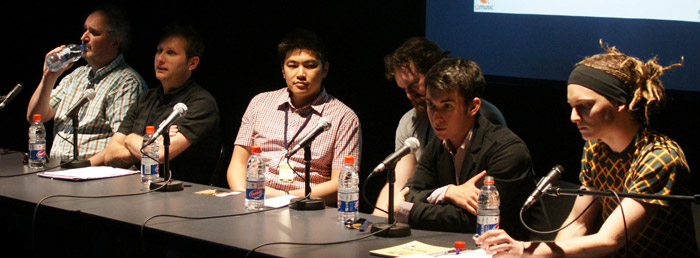
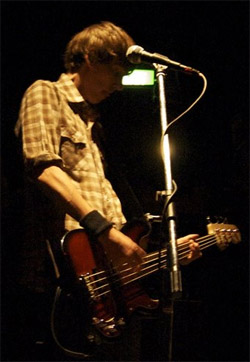 Ian Rogers of Brisbane bands
Ian Rogers of Brisbane bands  Brisbane natives
Brisbane natives 
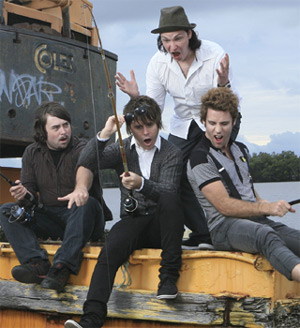 Brisbane’s
Brisbane’s 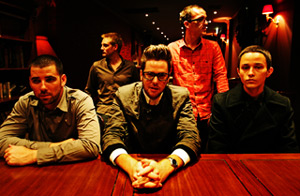 “I’m still a huge fan of putting on an album and listening to it all the way through. It’s very rare to experience an album that you can listen to from start to finish, and not get bored. It’s very rare to experience that, and it’s one of the things you look forward to in life, as a music fan – that next band that you’ll become completely obsessed with.” When questioned about the free MP3 downloads offered on the band’s Last.FM profile, Donaldson continues: “It’s still good for people to be able to download a song in reasonable quality, just in case they are thinking about downloading the full album. Because we’ve basically arrived at the situation where you can download a song for free, get a feel for the quality of it, and then decide whether you want to waste your bandwidth on it!”
“I’m still a huge fan of putting on an album and listening to it all the way through. It’s very rare to experience an album that you can listen to from start to finish, and not get bored. It’s very rare to experience that, and it’s one of the things you look forward to in life, as a music fan – that next band that you’ll become completely obsessed with.” When questioned about the free MP3 downloads offered on the band’s Last.FM profile, Donaldson continues: “It’s still good for people to be able to download a song in reasonable quality, just in case they are thinking about downloading the full album. Because we’ve basically arrived at the situation where you can download a song for free, get a feel for the quality of it, and then decide whether you want to waste your bandwidth on it!” It’s a valid comment, given that hip-hop song structures are perhaps more reliant on narrative than their rock counterparts. When asked about digital distribution’s effect on the album format, Levinson concedes: “It’s slowly changing people’s attitudes and expectations toward consumption of music. We’re in a transition period where albums retain a huge significance – but some signs suggest it’s disappearing. Stranger things have happened and trends don’t always result in their predicted outcome, though.”
It’s a valid comment, given that hip-hop song structures are perhaps more reliant on narrative than their rock counterparts. When asked about digital distribution’s effect on the album format, Levinson concedes: “It’s slowly changing people’s attitudes and expectations toward consumption of music. We’re in a transition period where albums retain a huge significance – but some signs suggest it’s disappearing. Stranger things have happened and trends don’t always result in their predicted outcome, though.” Neil: I think it depends on how you value success, really, in terms of shooting for the top. I think we’ve taken a very long-term view to a lot of the ventures that we’ve launched. I think the game we’re in is not a make-a-quick-buck game, by any stretch of the imagination. I think our intent here is of running inthemix, for example, and sites like FasterLouder, and Mess+Noise, and [gay/lesbian community]
Neil: I think it depends on how you value success, really, in terms of shooting for the top. I think we’ve taken a very long-term view to a lot of the ventures that we’ve launched. I think the game we’re in is not a make-a-quick-buck game, by any stretch of the imagination. I think our intent here is of running inthemix, for example, and sites like FasterLouder, and Mess+Noise, and [gay/lesbian community] 
 When we were initially presented with the opportunity to acquire Mess+Noise, we were really interested in the community. We really loved what they’ve been able to create and recognized how unique it was, in the sense that it really didn’t take a lot of time and a lot of different factors to create success in terms of doing a community online. Those guys have achieved that really well.
When we were initially presented with the opportunity to acquire Mess+Noise, we were really interested in the community. We really loved what they’ve been able to create and recognized how unique it was, in the sense that it really didn’t take a lot of time and a lot of different factors to create success in terms of doing a community online. Those guys have achieved that really well.

 It’s a lot more people coming to us now. It used to be, in the early stages, us going out there and trying to tell people about what we’re doing. We’ve never really been out there in terms of pitching all the time, and trying to win big pitches. We have taken the approach that what we’re offering is quite a specialist thing and it doesn’t suit all brands; it only suits certain types of brands at some stage in their lifecycle. More often, they’ve kind of found us rather than us finding them.
It’s a lot more people coming to us now. It used to be, in the early stages, us going out there and trying to tell people about what we’re doing. We’ve never really been out there in terms of pitching all the time, and trying to win big pitches. We have taken the approach that what we’re offering is quite a specialist thing and it doesn’t suit all brands; it only suits certain types of brands at some stage in their lifecycle. More often, they’ve kind of found us rather than us finding them. With
With 
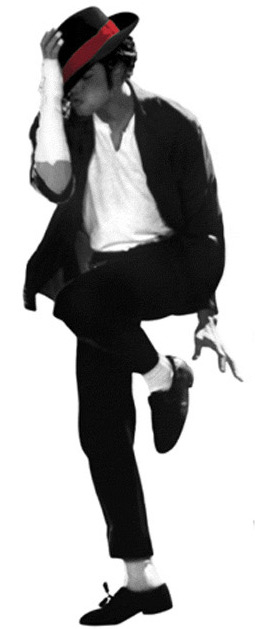 Regardless, Jackson’s enormous sales in the US simply couldn’t have eventuated ten years ago. Record stores inventories would’ve been exhausted across the country, and compact disc factories would’ve rushed to press more discs to meet the demand. Both of these outcomes still eventuated, but instead of experiencing weeks-long delays, music consumers have the option of instant online gratification: his 2.3 million download count resulted in six Jackson tracks appearing in the Billboard top ten.
Regardless, Jackson’s enormous sales in the US simply couldn’t have eventuated ten years ago. Record stores inventories would’ve been exhausted across the country, and compact disc factories would’ve rushed to press more discs to meet the demand. Both of these outcomes still eventuated, but instead of experiencing weeks-long delays, music consumers have the option of instant online gratification: his 2.3 million download count resulted in six Jackson tracks appearing in the Billboard top ten. At a national level, ARIA’s
At a national level, ARIA’s